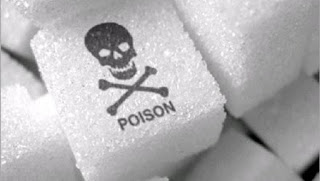Do you know how much sugar you consume daily? You may not, since there is currently no requirement that added sugars be shown separately on the ingredient labels of commonly consumed American food products. While many in the sugar and food industry want to see “personal responsibility” trump government regulation of food and ingredients, consumers are ill-equipped to exercise that responsibility when levels of added sugars are not disclosed. Many health advocates strongly feel that we have a right to know what we’re eating. How about you? Here’s just one example of the need for greater consumer awareness. In 2011, the Environmental Working Group (EWG) reviewed the sugar content for more than 80 popular cereals marketed to children. The results? Most were so sugar laden, they would easily qualify as desserts. Would you believe that a single cup of 44 of the brands tested serves up more sugar than a handful of Chips Ahoy cookies?
Scientists at the University of California, San Francisco (UCSF) take the issue pretty seriously, arguing that added sweeteners pose a clear danger to public health. Their research suggests that sugar is “toxic beyond its calories,” and should be regulated like alcohol and tobacco.(1) According to the American Heart Association (AHA), Americans’ average intake of added sugars is around 22.2 teaspoons per day─or 355 calories. Ouch! Compare this with the AHA recommended limit for added sugar of 100 calories for women, and 150 for men. Worldwide consumption of sugar has tripled over the past 50 years, mirrored by the dramatic increase in American obesity, and many associated problems. One study found, for example, that a high consumption of sugary drinks is associated with the development of metabolic syndrome and type 2 diabetes, and that intake should be limited to reduce obesity-related risk of chronic metabolic diseases.(2) Sugar intake is also proven to increase dyslipidemia, a blood fat profile known to increase cardiovascular disease risk.(3) And sugar directly increases cardiovascular disease risk among adults─children too!(4)
So how do you start scaling back? Try these ideas on for size:
• Boost nutrition and satisfy a sweet tooth with a nourishing, satiating whey protein shake each morning. Mix it up with organic berry, chocolate or other versions.
• Minimize all processed/packaged food, frozen desserts, and commercial baked goods.
• Make whole, fresh, organic fruit your go-to snack. Same for your kids!
• Avoid high fructose corn syrup─a GMO darling─whenever possible.
• Get an ice cream maker to create your own stevia/agave nectar-sweetened treats.
• Swap juice for hot/iced fruit or herbal teas, or mix unsweetened juice 50/50 with plain or sparkling water.
• Nix chocolate unless it’s fair trade. It’s higher quality, so you’ll eat less, and feel better about what you consume.
• Swap “energy drinks” for pure water or iced caffeine-free green tea for a gentle, antioxidant-rich lift.
• If you imbibe, skip the sugary mixers in cocktails. Better yet, stick to resveratrol-dense red wine.
While there’s far more to say on this topic, these insights should help. Here’s to life being sweet and healthy!
References
1 http://www.connectwell.biz/pdf/comment_truth_about_sugar.pdf
2 Diabetes Care. 2010 Nov;33(11):2477-83. Epub 2010 Aug 6.
3 JAMA. 2010 Apr 21;303(15):1490-7.
4 Circulation. 2011 Jan 25;123(3):249-57. Epub 2011 Jan 10.
